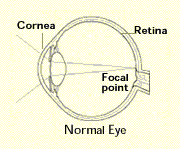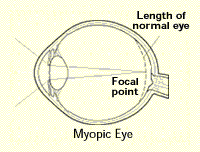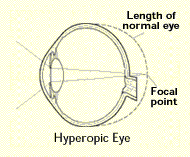The health, safety and well-being of our patients remains our top priority during the COVID pandemic. The UCSF Department of Ophthalmology is implementing a recovery plan to resume patient clinical and surgical care while making every effort to contain the spread of COVID-19. We have taken a number of steps to ensure the safety of all our patients visiting our practices (Clinic Visit Fact Sheet) and our operating rooms (Surgery Visit Fact Sheet) during these times. We value the opportunity to provide you the best in eye care. Should you have an urgent eye problem, please contact us at (415) 353-2020. The following UCSF websites are also provided for reference: Resources for Patients and Preparedness for Surgery and Other Procedures
Understanding Vision
The Normal Eye

The Myopic Eye

The nearsighted eye (myopia) is somewhat longer than the normal eye. This causes the light rays to focus at a point in front of the retina, resulting in a blurry view of distant objects.
The Hyperopic Eye

The farsighted eye (hyperopia) is shorter than normal. Light rays are aimed at a focus point behind the retina causing blurring of objects viewed up close.
Other common vision problems include astigmatism and presbyopia. With astigmatism the curvature of the cornea is uneven, causing a distortion of images. This distortion is especially noticeable after dark and with bright lights. With astigmatism, objects at all distances appear blurred.Presbyopia is caused by a loss of focusing flexibility in the eye and affects everyone, often starting in the mid-forties . This makes it difficult to view objects up close while wearing corrective eyewear for nearsightedness. People with this condition often wear reading glasses and bifocals (glasses that focus different ways for up close and distance viewing). Alternatively, if they are nearsighted, they may read by removing their eyeglasses and using their nearsightedness to read.
Understanding Vision
The Normal Eye

The Myopic Eye

The nearsighted eye (myopia) is somewhat longer than the normal eye. This causes the light rays to focus at a point in front of the retina, resulting in a blurry view of distant objects.
The Hyperopic Eye

The farsighted eye (hyperopia) is shorter than normal. Light rays are aimed at a focus point behind the retina causing blurring of objects viewed up close.
Other common vision problems include astigmatism and presbyopia. With astigmatism the curvature of the cornea is uneven, causing a distortion of images. This distortion is especially noticeable after dark and with bright lights. With astigmatism, objects at all distances appear blurred.Presbyopia is caused by a loss of focusing flexibility in the eye and affects everyone, often starting in the mid-forties . This makes it difficult to view objects up close while wearing corrective eyewear for nearsightedness. People with this condition often wear reading glasses and bifocals (glasses that focus different ways for up close and distance viewing). Alternatively, if they are nearsighted, they may read by removing their eyeglasses and using their nearsightedness to read.
